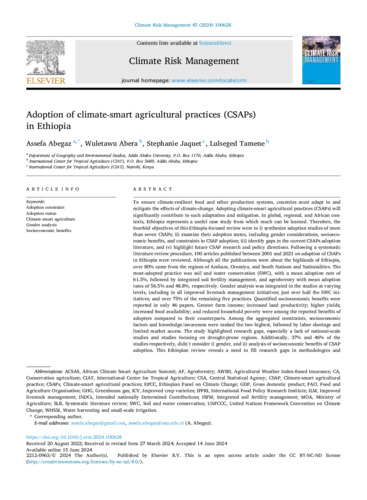Adoption of Climate-Smart Agricultural Practices (CSAPs) in Ethiopia
To ensure climate-resilient food and other production systems, countries must adapt to and mitigate the effects of climate-change. Adopting climate-smart agricultural practices (CSAPs) will significantly contribute to such adaptation and mitigation. In global, regional, and African contexts, Ethiopia represents a useful case study from which much can be learned. Therefore, the fourfold objectives of this Ethiopia-focused review were to i) synthesize adoption studies of more than seven CSAPs; ii) examine their adoption status, including gender considerations, socioeconomic benefits, and constraints to CSAP adoption; iii) identify gaps in the current CSAPs adoption literature, and iv) highlight future CSAP research and policy directions. Following a systematic literature review procedure, 100 articles published between 2001 and 2021 on adoption of CSAPs in Ethiopia were reviewed. Although all the publications were about the highlands of Ethiopia, over 80% came from the regions of Amhara, Oromiya, and South Nations and Nationalities. The most-adopted practice was soil and water conservation (SWC), with a mean adoption rate of 61.5%, followed by integrated soil fertility management, and agroforestry with mean adoption rates of 56.5% and 48.8%, respectively. Gender analysis was integrated in the studies at varying levels, including in all improved livestock management initiatives; just over half the SWC initiatives; and over 75% of the remaining five practices. Quantified socioeconomic benefits were reported in only 46 papers. Greater farm income; increased land productivity; higher yields; increased food availability; and reduced household poverty were among the reported benefits of adopters compared to their counterparts. Among the aggregated constraints, socioeconomic factors and knowledge/awareness were ranked the two highest, followed by labor shortage and limited market access. The study highlighted research gaps, especially a lack of national-scale studies and studies focusing on drought-prone regions. Additionally, 37% and 46% of the studies respectively, didn’t consider i) gender, and ii) analysis of socioeconomic benefits of CSAP adoption. This Ethiopian review reveals a need to fill research gaps in methodologies and practices, and at all levels in all regions, particularly in drought-prone regions. It identifies those CSAPs which could contribute more to addressing climate change, and emphasizes the need for greater gender inclusion. Policy-related actions should i) boost CSAP-related knowledge; ii) support optimizing their socioeconomic benefits; iii) address labor shortages; iv) improve access to irrigation, markets; credit, and farmers’ social organizations; and v) strengthen land tenure. In future, deploying remote-sensing technology, artificial intelligence and modelling approaches, and implementing Agricultural Weather Index-Based Insurance may also support CSAPs adoption.

